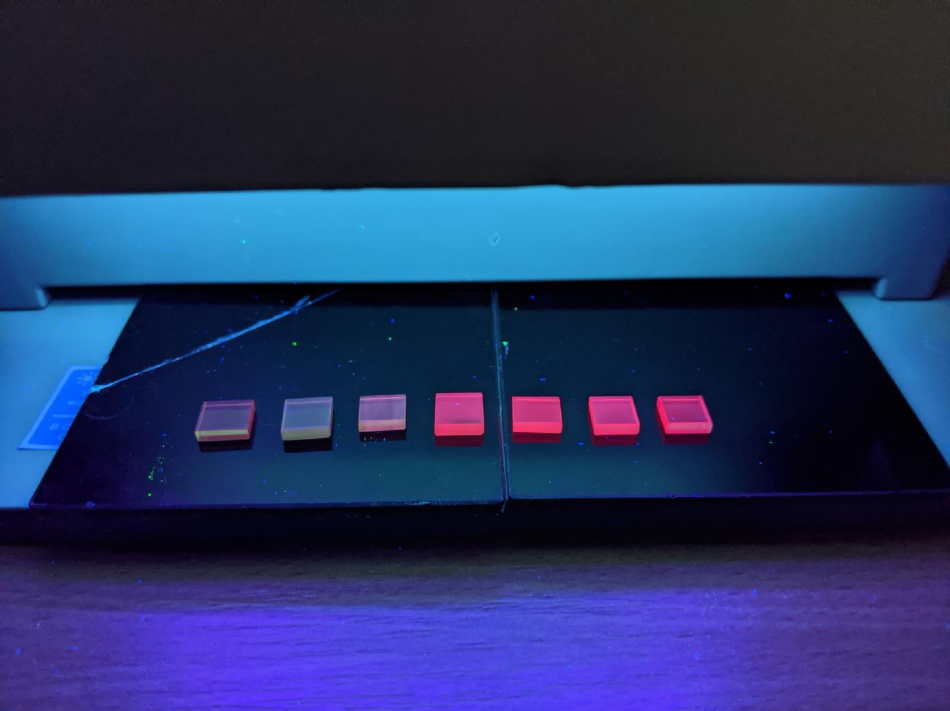Jun 9 2020
Many individuals would have observed bright pink light in a few windows. This light comes from particular lamps that are utilized to provide sufficient lighting to house plants.
 Light sources created from ceramics with the addition of chrome: the light from such lamps offers not just red but also infrared (IR) light, which is expected to have a positive effect on the growth of plants. Image Credit: Anastasiia Babkina.
Light sources created from ceramics with the addition of chrome: the light from such lamps offers not just red but also infrared (IR) light, which is expected to have a positive effect on the growth of plants. Image Credit: Anastasiia Babkina.
Lamps of the same kind are also utilized by farmers in greenhouses. Yet, experts in the field of photophysiology claim that these lamps do not provide all the light required by the plants.
ITMO researchers together with their collaborators from Tomsk Polytechnic University have proposed a new concept to produce light sources from ceramics by adding chrome: the light from these lamps provides not only red but also infrared (IR) light, which is anticipated to have a positive impact on the growth of the plants.
The study was performed as part of a Russian Science Foundation grant, and the study outcomes were reported in the Optical Materials journal.
When compared to open space, growing berries, fruits, and vegetables in large greenhouses is turning out to be highly common. Plants grown in such facilities are safeguarded from cold, droughts, and hail. However, in these greenhouses, it is essential to compensate for the absence of natural sunlight.
In sophisticated agricultural facilities, light diodes are used as they use a little amount of energy, provide bright light, and can be easily installed in a greenhouse. They emit pink light, which is generated by concurrent use of red and blue diodes.
Scientists found out that such lighting isn’t optimal. Thing is, a red diode lights in the range of about 650 nanometers, and its spectrum is very narrow, similar to that of a laser. Plants, however, absorb red and IR light better in the range that’s a bit more than 650 nanometers, which people can barely see. So you see, this means that we use the light that’s more comfortable for humans and not optimal for plants.
Anastasia Babkina, Lab Assistant, Faculty of Photonics and Optical Information, ITMO University
This implies that it is necessary to identify a material that can be utilized in light diode lamps such that they would generate light of a broader spectrum, such as the IR range. Researchers from ITMO and Tomsk Polytechnic University pursued this task.
In conventional red-light diodes, materials based on europium and manganese compounds are used. The crystals of this chemical element enable the diode to emit at the wavelength of around 650 nm, creating the light red and combined with the emission of the blue diode—pink.
We decided to use not a different crystal but glass-ceramics. This is a transitive material between glass and crystal. What’s the difference? We have to specifically grow crystals, whereas glass is synthesized by moulding, and it can be produced quickly and in large amounts, in any shape you need.
Anastasia Babkina, Lab Assistant, Faculty of Photonics and Optical Information, ITMO University
Babkina continued, “The drawback is that glass is fragile. For this reason, we take glass and begin to slowly crystallize it so that it doesn’t lose transparency. In result, we get glass with microscopic crystals inside that are invisible to the eye. Such a material is more sturdy, has better luminescent properties—and is called glass-ceramics.”
At the production stage, the addition of chrome to the glass-ceramics gives the material a pink tone that enables it to generate IR and red light simultaneously. The new material could find two possible applications.
The first one is to mill it to obtain microparticles that can be utilized to make light diodes of a new kind. Although this provides huge prospects, the launch of such technology needs a lot of money and time. One more choice is to use it to make lampshades.
We can take blue and green light diodes and use our glass-ceramics as a filter to obtain a wide-spectrum emission that will include the IR range.
Anastasia Babkina, Lab Assistant, Faculty of Photonics and Optical Information, ITMO University
Journal Reference:
Babkina, A., et al. (2020) Spectroscopic properties of chromium/antimony co-doped alkali-alumina-borate glass-ceramics. Optical Materials. doi.org/10.1016/j.optmat.2020.109983.